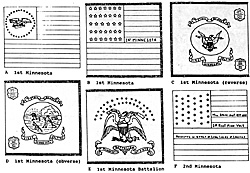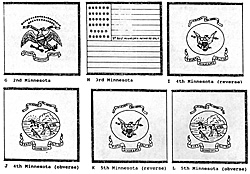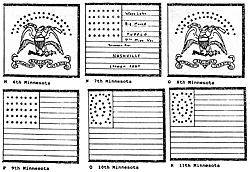In 1858 Minnesota was admitted as the thirty-second state of the Union. Three years later, largely still a frontier state, Minnesota responded to Lincoln's call for volunteers by raising four regiments of infantry. In the course of the next four years, an additional seven regiments were called up to serve against the Confederates or on the threatened western frontier.
At the end of hostilities the various colors so proudly borne by these Minnesotans were returned to the state. Presently these colors are on display in the rotunda of the Capitol in St. Paul, a fitting tribute to the bravery of the 24,020 Minnesotans who served their country in its time of need.
The following illustrations are all to 1/30 scale. For the most part, the original colors measure 72 inches on the staff by 78 inches on the fly.
A. 1st Minnesota National Color
This color was presented to the 1st Minnesota in April or May of 1861 by the ladies of Winona and subsequently carried at the Battle of Bull Run. The device in the canton, including the stars, is painted in gold.
B. 1st Mnnesota National Color
The replacement for the previous color, this flag has white stars and a gold unit designation.
C. 1st Minnesota Regimental Color (reverse)
Governor Ramsey presented the lst Minnesota with this color, made by the ladies of St. Paul, in April 1863. The exact design and the coloration of the national arms, displayed on a white background cannot be stated with certainty as most of the original device has deteriorated. Nevertheless, the remaining fragments indicate the illustrated design. Above the center arms, the banner with the state motto is light blue with gold lettering. The lower banner is red with gold lettering. Overall the color has a dark blue filed and gold fringes. The two shields on the right are also outlined and lettered in gold. The shields list the names and dates of the regiment's battles as follows: Upper Shield Bull Run/July 21, 1862/Ball's Bluff/Oct. 21, 1862/Siege of Yorktown/April 1862/Allen's Farm/June 29, 1862.
Lower Shield Savage Station/June 29, 1862/White Oak Bridge/June 30, 1862/Glendale/June 30, 1862/Malvern Hill/July 1, 1862/Antietam/Sept. 17, 1862
D. 1st Minnesota Regimental Color (obverse)
This side of the flag is in the same coloration as its reverse. The central device, however, is the Minnesota state seal. It has a light blue sky, white clouds, green ground, and blue river and waterfall. The sun is red with yellow rays. The Indian on the left rides a brown horse; the farmer is wearing white trousers, red shirt, and black hat. His plough is brown as is his rifle leaning on the brown stump in the foreground.
E. 1st Mnnesota Battalion Regimental Color
The three year term of enlistment of the 1st Minnesota Regiment expired in April 1864. The 1st Minnesota Battalion was formed the following month from a cadre of 1st Minnesota re-enlistees and new recruits., Its regimental color is of the pattern issued by the New York Quartermaster. It has a brown and white eagle grasping yellow arrows and a green olive branch with a white banner held in the eagle's beak. The banner is edged and lettered in gold. On the eagle's breast is a red, white and blue shield which is outlined in gold. Below the eagle is a red banner similarly edged and lettered in gold; above the eagle are 34 gold stars. The color's field is dark blue and it has gold fringes.
F. 2nd Minnesota National Color
The Loyal Ladies of Louisville presented the 2nd Minnesota with this flag following the Battle of Mill Springs (at Logan's Crossroads) in January 1862. The color is peculiar in having a white canton with dark blue stars. All lettering on the three red stripes is in gold.
G. 2nd Minnesota Regimental Color
This color was apparently carried by the 2nd Minnesota on Sherman's march through Georgia and the Carolinas. It is of the pattern issued by the Cincinnati Quartermaster with a natural colored eagle on a blue field. The eagle is holding yellow arrows and a green olive branch and has a red, white and blue shield, outlined in gold, on its breast. The eagle also has a midblue gold lettered banner in its beak. Above the eagle are 34 gold stars and below the eagle is a red banner lettered and edged in gold. The fringes are also gold.
H. 3rd Minnesota National Color
In contrast to the previously described national color, this flag adhere closely to regulations. It has gold stars., lettering and fringes.
I. 4th Minnesota Regimental Color (reverse)
J. 4th Minnesota Regimental Color (obverse)
K. 5th Minnesota Regimental Color (reverse)
L. 5th Minnesota Regimental Color (obverse)
The colors of the 4th and 5th Minnesota are almost identical in design and coloration to that of the 1st Minnesota. The only differences are the lack of the small shields listing the units' battle honors and the slightly different banner bearing the state motto. As well, this banner is mid-blue in color.
M. 6th Minnesota regimental Color
This color is identical in style and coloration to that of the 1st Minnesota Battalion.
N. 7th Minnesota National Color
This color has 34 gold stars, gold fringes and gold lettered regimental designation. The unit's battle honors, in various styles of lettering, are in black.
0. 8th Minnesota Regimental Color
Again, this color is identical to that of the 1st Minnesota Battalion.
P. 9th Minnesota National Color
Q. 10th Minnesota National Color
R. 11th Minnesota National Color
Although the cantons are dissimilar in design, all three of these colors have gold stars and fringes.



Back to The Zouave Vol VI No. 1 Table of Contents
Back to The Zouave List of Issues
Back to Master Magazine List
© Copyright 1992 The American Civil War Society
This article appears in MagWeb (Magazine Web) on the Internet World Wide Web.
Other military history articles and gaming articles are available at http://www.magweb.com